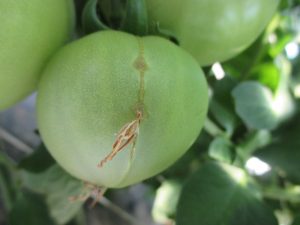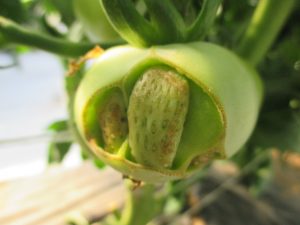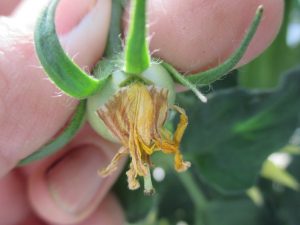Recent cool weather increases the occurrence of zippering on high tunnel tomatoes. We observed at least 20% of developing fruit (most on the first and second flower clusters) on the variety Mountain Spring showed the zippering symptoms in our high tunnel. A typical symptom of the disorder is a thin, brown, necrotic scar that starts from the stem end and extend fully or partially to the blossom end. The reason the symptom is called zippering is because transverse scars are along with the longitudinal scar that looks like a zipper (Figure 1). In more severe cases, the scar is open and reveal locule (Figure 2). In the initial stage, zippering is often observed with anthers adhering to the fruit (Figure 3), the attached anthers is believed to disturb fruit development and cause the symptom.
Zippering symptom is more noticeable with cool weather. Optimum temperatures for tomato fruit set are 60-75°F (night) and 60-90°F (day). In the past week, when the lowest night temperatures were in the range of 40s during the cloudy days, the lowest night temperatures inside high tunnel were also below 50°F, lower than the optimal fruit-set temperatures. To reduce zippering tomatoes, maintain idea temperature during tomato fruit set is important. In addition, select varieties that are not prone to zippering. In a study conducted at Southwest Purdue Agricultural Center, we found ‘Red Deuce’ was less susceptible to zippering than ‘Mountain Spring’ under the similar environmental conditions.


